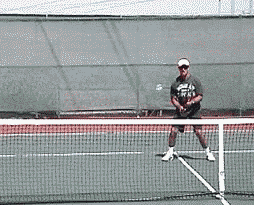|

The Open Stance Volley
Cris Bacharach
Many times I hear my students complain about
being too slow to react at the net or volleying too many balls off the
frame. The open stance volley may be the answer to both of these problems.
Open stance is a simple solution for quicker footwork on wide
volleys. So many of us are taught to step across with the opposite foot for better volleys.
This may work well when you only have to move a half or full step to reach
the ball. However, when your opponent hits a wide volley and you have to
take two or more steps, you are better off volleying with an open stance
and saving the cross step as a last resort. And with out the cross
step, you can recover and reload for the next ball more quickly.
Make sure to start with the outside foot first (right-hander going for
a wide forehand starts with his right foot first) and shuffle to the ball.
|

The open stance allows me to see the ball better and by saving a
step, I can recover more quickly. |
Balance and Vision
Good
balance and focal vision are two key ingredients for a consistent,
powerful net game. The open stance improves both.
Because the open stance allows you to face the incoming ball, I believe
it also allows you to see it more clearly,
ultimately improving your volleys (less framers).
The open stance provides a more stable balance position and involves less head movement
than traditional volleys. Good balance and a quiet head make it easier
track the ball and put your weight
behind each volley. Practice with a Ball Machine
|

Practice with a friend to acclimate yourself, then try it using a
ball machine. |
The best way to practice the open stance volley is with the ball machine.
Set the ball machine for a shot down the line without any variation (set
oscillation to zero). Position yourself half way from the service line and
the net. From the middle of the court begin shuffling to execute the shot.
Donít forget to move with the outside foot first.
If you are having difficult time adjusting, have your practice partner stand
in the doubles alley while you stand just one step out side of it (in the
court). Have your practice partner gently toss the ball
under hand into the alley so you have to take a step (right foot) into the
doubles alley to execute the volley.
After mastering this, make it a bit tougher. Move away from the singles
line so that when your partner tosses the ball you now have to take 2-3 steps into the alley
to execute the volley.
Once you feel comfortable with this drill, try using the ball machine
again. Practice using the ball machine for 10 Ė15 minutes 2-3 times a week.
In a month, you'll be tournament ready.
Your comments are welcome. Let us know what you think about
Cris
Bacharach's article by emailing
us here at TennisONE. |